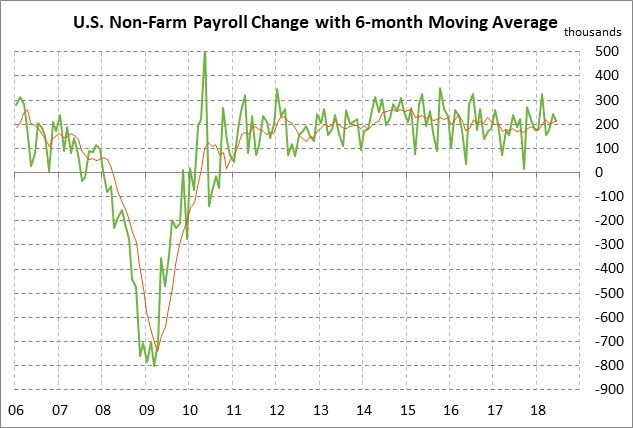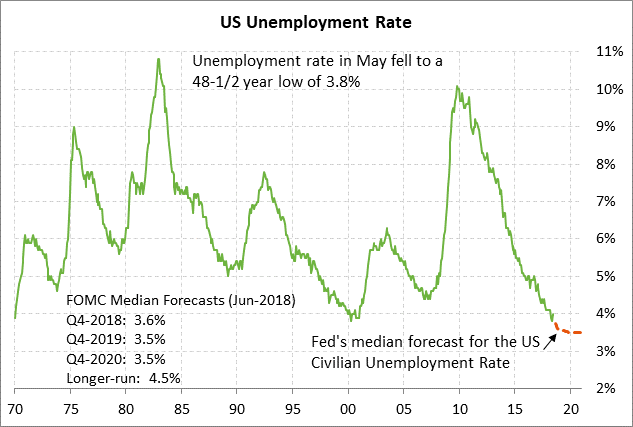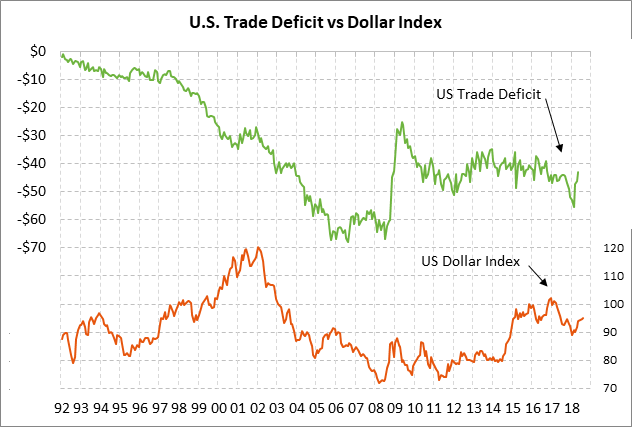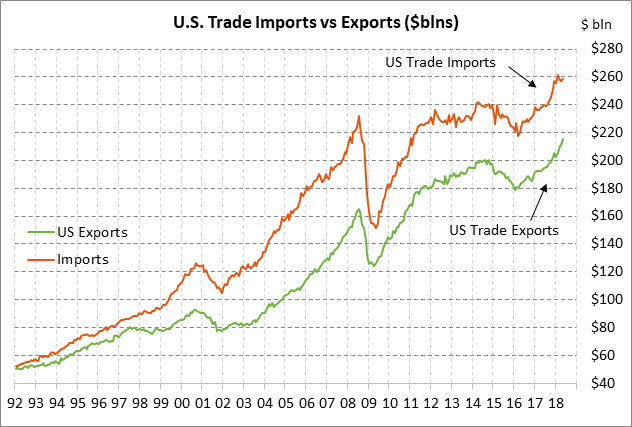- U.S. unemployment report expected to show continued strength in labor market, supporting the Fed’s rate-hike plans
- ISM non-manufacturing index expected to show continued strong business confidence
- U.S. trade deficit expected to widen as exports fall back
- BOE’s rate hike decision is unanimous but the next rate hike isn’t expected until 2019
- BOJ intervenes before yield reaches 0.20% upper target limit
U.S. unemployment report expected to show continued strength in labor market, supporting the Fed’s rate-hike plans — Today’s July unemployment report is expected to show continued strength in the U.S. labor market that would reinforce the Fed’s rate-hike plans. A particularly strong payroll report today could even boost the odds that the Fed will end up with four rate hikes this year. The market is discounting 100% odds for a rate hike at the next FOMC meeting on September 25-26 and 80% odds for the fourth rate hike of the year at the December 18-19 meeting.
The market consensus is for today’s July payroll report to show another solid increase of +190,000, down from June’s strong report of +213,000. The expected report of +190,000 would be just mildly below the 12-month trend average of 198,000. The ability of the U.S. economy to continue to produce so many jobs is impressive despite the fact that the pool of available workers is drying up and that the U.S. economy has already produced 19.2 million jobs since the Great Recession.
Meanwhile, the consensus is for today’s July unemployment rate to fall -0.1 point to 3.9%, which would be only 0.1 point above May’s 48-year low of 3.8%. The Fed is forecasting that the U.S. unemployment rate will fall farther to 3.6% by the end of this year and to 3.5% during 2019-2020.
The Fed continues to believe that there is a sufficient supply of workers to allow the unemployment rate to continue to drop without sparking a big increase in wages. The current labor force participation rate of 62.9% is relatively low at only 0.6 points above the 4-decade low of 62.3% posted in Sep 2015 and well below pre-recession level of about 66%. That indicates that there are still many people sitting on the sidelines of the U.S. labor market, some of whom could be drawn back into the labor market if wages and job quality were attractive enough.
However, the number of people in the labor market is not going to climb back to pre-recession levels because there are structural reasons for the drop in participation such as baby-boomer retirements and increased social problems such as drug addiction. That means that a further drop in the unemployment rate is likely to put at least some upward pressure on wages.
The market consensus is for today’s July average hourly earnings report to be unchanged from June’s +2.7% y/y. Hourly earnings have been stuck in the narrow range of 2.6-2.7% since February, which is just below January’s 9-year high of +2.8% y/y. However, if wage growth today should break out above the 9-year high of +2.8%, that would quickly spark an increase in inflation expectations and a sell-off in T-notes.
ISM non-manufacturing index expected to show continued strong business confidence — The market consensus is for today’s July ISM non-manufacturing index to show a -0.5 point decline to 58.6, exactly reversing June’s +0.5 point increase to 59.1. The index is in strong shape at only -0.8 points below January’s 13-year high of 59.9, illustrating that confidence in the non-manufacturing sectors of the U.S. economy remains very strong.
Business confidence remains high due to the very strong Q2 GDP growth rate of +4.1%, the sharp pickup in consumer spending in Q2, and flush corporate cash positions after the Jan 1 tax cuts. However, headwinds include high gasoline prices, Washington political uncertainty, and tariffs.
U.S. trade deficit expected to widen as exports fall back — The market consensus is for today’s June trade deficit to expand moderately to -$46.5 billion from May’s -$43.1 billion. The U.S. trade deficit in May dipped to a 1-1/2 year low but is expected to rebound to -$46.5 billion in June, which would be just mildly below the 12-month trend average of -$47.5 billion.
The narrower trade deficit in May was due to a big +1.9% m/m jump in exports to a record high of $215.3 billion. That spike in exports was due in part to the temporary factor of buyers trying to beat the implementation of retaliatory tariffs on U.S. products. Export growth in May grew sharply by +11.7% y/y while import growth was slower at +8.3% y/y.
BOE’s rate hike decision is unanimous but the next rate hike isn’t expected until 2019 — The Bank of England at its meeting on Thursday met market expectations by raising its policy rate by +25 bp to 0.75%. However, the decision was on the hawkish side since the decision was unanimous versus expectations that one or two MPC members would dissent. The unanimous decision illustrated that MPC members are more hawkish than earlier thought.
However, the market now believes that the BOE is not likely to raise rates again until after March 2019 when it becomes clear whether Brexit goes smoothly or whether the UK instead crashes out of the EU without a deal, in which case the BOE may be looking at a rate cut rather than a rate hike. The market is currently discounting only a 14% chance of a rate hike by this December.
BOJ intervenes before yield reaches 0.20% upper target limit — The BOJ on Thursday intervened to purchase 400 billion yen worth of JGBs even though the 10-year JGB yield had not yet risen as high as the BOJ’s new upper target limit of 0.20%. The 10-year JGB yield rose to 0.142% on Thursday but then fell back after the BOJ’s bond purchase operation and closed the day -0.5 bp at 0.126%. The BOJ’s intervention on Thursday made clear that the BOJ intends to not only defend the 0.20% upper limit but also halt any sharp increases even if the yield is below the upper limit.






